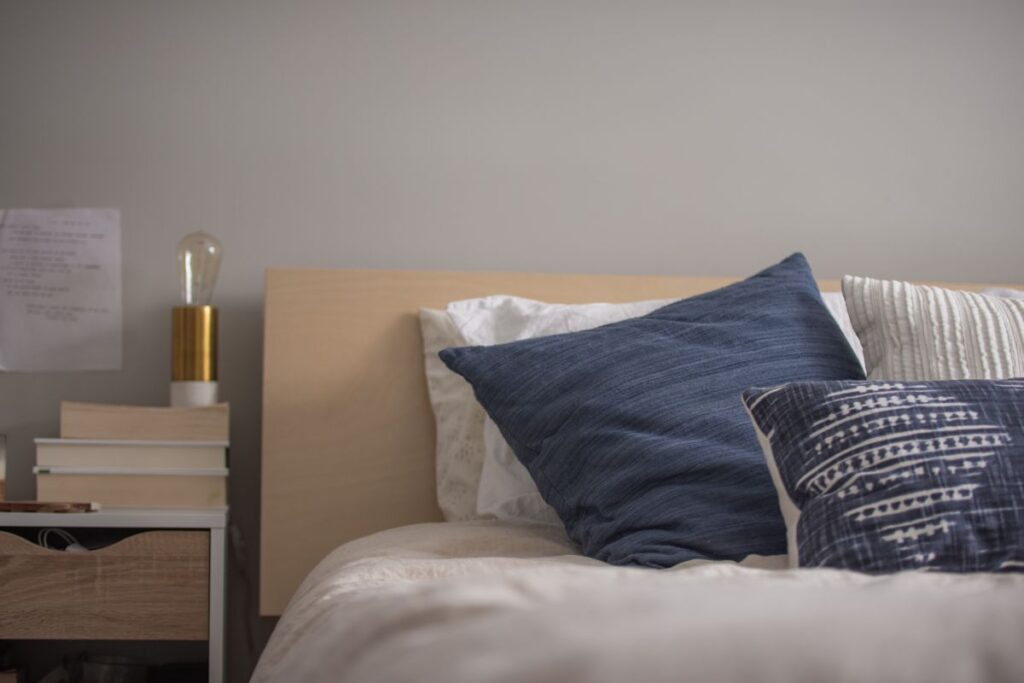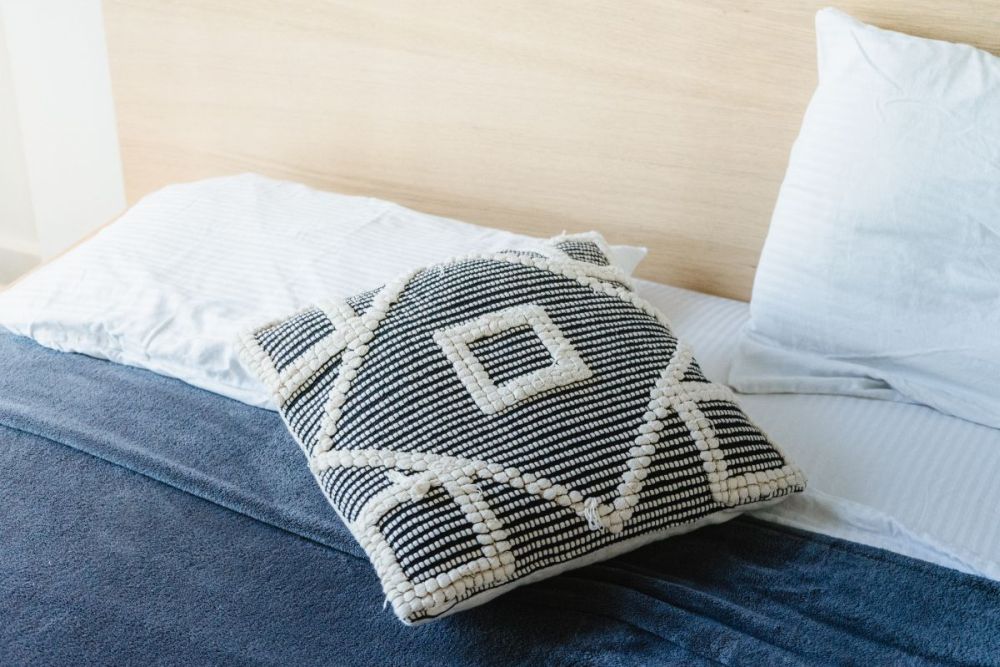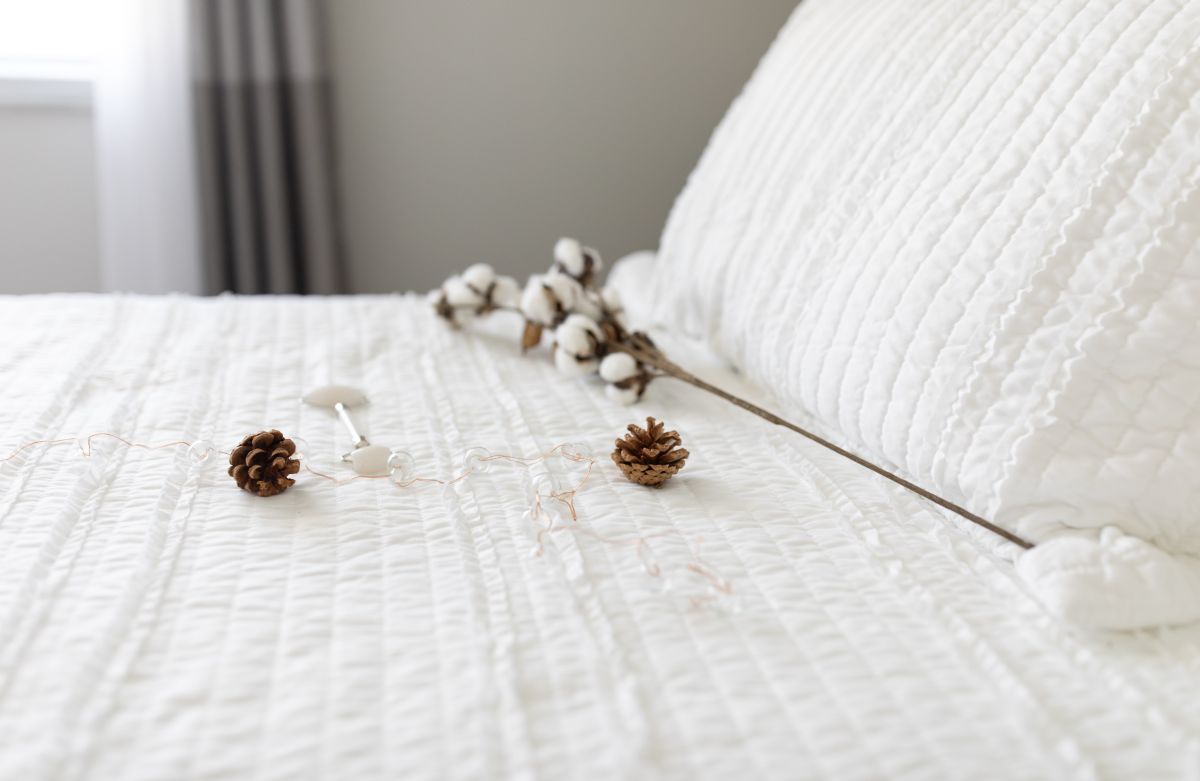Both linen & cotton are made from natural fibres, making them long-lasting, breathable, and soft. How do their views diverge? To compare linen and cotton, we can see that they benefit from distinct properties, such as breathability and absorbency. Natural fibres like linen and cotton are good for the environment, but there are some subtle distinctions between linen and cotton fabrics that set them apart.
What Exactly Is Cotton?
Cotton, being a staple fibre, is made up of strands of variable lengths. Cotton is woven from the seeds and stems of the cotton plant. Fabric is made from the boll, which is the protective covering for the cotton plant's fluffy fibres. Fabrics made from cotton are resilient despite their fluffy and light nature.
Cotton Sheets: Pros And Cons
What We Like About Cotton Sheets
A Wide Range Of Design Options
You can find high-end cotton sheets in a wide range of hues, prints, and textures to complement your current bedding set or create a brand new one.
Several Weaves
The versatility of cotton weaving means that a wide range of sumptuous sheet styles, including as sateen, percale, and Supima, are available.
Durable
The intricate weaving technique utilised to create luxury cotton sheets is what gives these linens their resilience, making them suitable for frequent usage.
Each Wash Softens It.
Cotton bed sheets may be cleaned repeatedly without losing their shape or softness.
Things We Would Change About Cotton Sheets
Wrinkled Easily
Luxury cotton sheets might require special care to prevent excessive creasing because cotton fabric wrinkles easily.
Less Long-lasting
Popular cotton sheets may not last as long as high-quality linen sheets, depending just on weave and quality of the cotton.
Shrinkage
Cotton sheets do shrink, unfortunately. It's inherent to the material itself. Luxury cotton sheets will shrink less if washed in cool water.
What Exactly Is Linen?
Flax, a species of the family Linum with in family Linaceae, is used to create linen, a fabric that is both durable and incredibly breathable. The Latin word for flax is linum usitatissimum, from which we get the English word "linen." Even though flax is a natural material, it takes more time to collect and process into linen since the strands can be challenging to weave. After the fibres have been removed from the plant, they are stored for a long time to weaken them. Towels, tablecloth, napkins, and bedsheets are all commonly made from linen. Even though not all of these goods are actually manufactured from linen, the word "linens" is nonetheless used to describe them.
The Benefits And Drawbacks Of Linen Sheets
What We Like About Linen Sheets
Durability
When cared for properly, a set of linen bedding can last for decades.
Hypoallergenic
In the opinion of medical authorities, linen sheets are hypoallergenic by design. This implies that folks with sensitive skin can sleep soundly on linen sheets without worry.
Moisture Wicking
Linen sheets naturally drain away sweat and have exceptional breathability, making for a comfortable night's sleep.
Eco-Friendly
Given that they are biodegradable when you're done with them and manufactured from flax seeds, linen sheets are widely regarded as eco-friendly.
Things We Would Change About Linen Sheets
Fewer Color Choices
The limited colour and pattern palette of most linen sheets makes it difficult to come up with unique and interesting themes for your bedroom.
Initially, A Coarse Sensation
It's not recommended to use brand-new luxury linen sheets straight from the package. You'll need to wash your linen sheets multiple times before they feel as soft as your cotton sheets.
Higher Initial Investment
Despite the fact that luxury linen sheets are more expensive than other options, they are ultimately more cost-effective because of how long they last.
Wrinkle Free
These sheets tend to wrinkle easily because the linen fibres used to make them lack tenacity and flexibility. This can often produce a crumpled appearance.
FAQs About Linen And Cotton
While cotton sheets and linen sheets both really do offer excellent breathability, some people feel that linen bedding sets may have a slight edge when it comes to keeping you cooler in warmer temperatures. Both of these highly breathable fabrics are also absorbable, which means that you stay cooler longer due to their superb wicking qualities. If your main concern is breathability, linen vs cotton sheets may work best for you, however, if you prefer a softer sheet, cotton is for you.
Cotton sheets and linen sheets are both great choices for cool weather. Cotton will make you feel warmer at first, but you may end up getting a little too warm, which is the case for many. Linen sheets, however, will retain the heat from your body, making you feel nice and cozy. Linen sheets feel heavier than cotton sheets and are about 30 percent stronger yet offer better breathability. For those who tend to get a little warm when sleeping, linen sheets are a perfect luxury bedding choice.
Linen is an excellent choice for luxury bedding items such as sheets, duvets, pillows, and more. In fact, it is a top choice of many hotels and vacation rental homes due to its durability and hypoallergenic qualities. Below are some of the pros and cons of linen sheets and cotton sheets so you can see how linen vs cotton sheets compare and which one will work best for your bedroom.
To put it simply, manufacturing linen is a laborious and timely process, from harvesting in the fields to fabric construction on the factory floor. Add geographical limitations of where the linen producing flax plant will grow and the result is a more costly purchase than the more easily produced cotton fabric.
Uses. Many products can be made with linen: aprons, bags, towels (swimming, bath, beach, body and wash towels), napkins, bed linens, tablecloths, runners, chair covers, and men's and women's wear. Today, linen is usually an expensive textile produced in relatively small quantities.
Cotton Vs. Linen: What Is the Difference?
There is a number of important differences among linen and cotton. These are some of them:
Durability
Cotton is stretchier and more adaptable than linen, but not as robust. High-quality cotton, such as Egyptian cotton, is made from cotton fibres that are longer than usual. This results in a fabric that is softer and more durable than standard cotton but not nearly as long-lasting as linen. Linen is stronger than cotton because its cellulose fibres are longer and packed tighter.
Texture
Cotton is a finer fabric, whereas the looser weave of linen gives it a more textured pattern.
Appearance
Since cotton fibres are weaker, cotton tends to pill more easily than linen. Linen, like cotton, is a natural textile that tends to wrinkle readily, albeit its somewhat stiffer texture makes it more noticeable than cotton.
Softness
Cotton feels better than linen because flax fibres are coarser. cotton sheets are quite soft right out of the box and can last around five years, whereas linen sheets become exceptionally soft after several washes and can last up to 40 years.
Hypoallergenic
Though both cotton & linen are hypoallergenic, the lower stitching and looser weave of linen make it preferable for those with allergies.
Absorbency
Water fortifies the linen and cotton fibres and makes them more absorbent. Although linen may absorb up to 20% of the its weight in water, cotton can hold over 25%.
Wicking Water
Linen is naturally water-wicking, meaning it absorbs moisture from the skin & dries swiftly. While cotton performs a good job of wicking sweat, it doesn't have the same inherent wicking power as linen does.
Breathability
The weave of cotton determines its breathability more than the fibres themselves, but both linen and cotton are breathable fabrics. Denim and canvas are examples of denser cotton weaves that don't allow much air circulation. However, flax linen fibres are porous, allowing air and water to pass through them freely. We hope you'll find this comprehensive guide to denim useful.
Warmth
Cotton is an excellent insulator when it does not heat up and is comparable in this regard to the widely used fibreglass. Because of the hollow nature of linen flax strands, linen is ideal for the warmer months, but it requires layering during the cooler winter months.
Cotton Vs. Linen Bedlinen
You need to be at ease in order to get a decent night's rest. The comfort level of linen bedding is unrivalled, even when compared to cotton, which is preferable to synthetic fibres. Not only are linen sheets luxuriously comfortable to sleep on, but they also offer natural temperature-regulating properties that will keep you fresh even on the warmest evenings and warm and snug when it's chilly outside. You won't wake up sweaty because of its natural capacity to drain moisture away from the body. You feel completely refreshed and ready to take on the day.
Why Are Linen Clothes Better Than Cotton Clothes?
We prefer linen sheets to cotton ones, but that's not all! The same temperature-regulating characteristics and luxurious softness may be found in linen clothing. Linen-clad individuals have been demonstrated to produce significantly less perspiration than cotton-clad individuals. Clothes made from linen are ideal for vacationing because they dry quickly and don't weigh you down.
Not only are they easy to throw in the wash without ironing, but their attractive crumples make them look even more put together. Dressing with linen creates an appearance of easy, breezy sophistication. They are simple, classic, and demonstrate that, despite your concern for your appearance, you are not easily swayed by fleeting fashion trends. You need clothes that can be worn in every situation, whether you're doing errands, going to a formal event, or just hanging out with friends and family.
Cotton garments are beautiful at first, but they tend to wear out quickly and lose their form after several washes. In contrast, linen only improves with repeated washings. In addition to being resistant to moths and bacteria, linen also resists odour and keeps clothes looking wonderful for longer.
Linen Is A More Sustainable Alternative
Linen fabric made from flax plant requires so much less water than cotton fabric of the same weight and quality to make. Because of this, it's a more environmentally friendly option. Flax requires a smaller amount of insecticides than cotton, and chemical processing is unnecessary for linen fibres. Which can do nothing except benefit Earth.
The cotton plant likewise needs a lot of space, although flax may thrive in poor soil. While organic cotton is a great option if you're looking to purchase eco-friendly clothes, it does necessitate additional space due to the lower crop yields that arise from the lack of chemicals permitted for organic cotton production. Linen uses less energy to produce than other fabrics, and when it has served its purpose, the cloth may be easily biodegraded without leaving any toxic byproducts or waste behind.
Better Texture, Appearance, And Feel
Linen fabrics are a popular choice among stylists for a variety of uses, including food styling, Instagramming, and decorating. They are simply more visually and texturally engaging than cotton alternatives. Linen is currently all the rage because its textured fibres provide dimension to an outfit, while cotton materials can appear flat and bland. Linen tablecloths and towels are all the rage for a reason, as they can be used for anything from chic picnics to photo shoots by the pool. Linen is beautiful whether you choose subdued, neutral colours like those seen in Scandi design, or vibrant, eye-catching accents. It's long-lasting, so it won't lose its lustre with time, and it really improves with age, as is the case with many quality possessions.
Conclusion
Linen and cotton are both durable, breathable, and soft because they are manufactured from natural fibres. Linen and cotton are both natural materials, yet there are nuances in their construction that distinguish one from the other. Whether you're looking to update your current bedding ensemble or start over, cotton sheets are a great place to start. Linen sheets are hypoallergenic because they are woven from flax seeds. Properly maintained, a linen set of sheets can last for decades.
Most linen sheets only come in a small selection of solid colours and simple patterns, limiting your options for creating a truly custom look in your bedroom. The linen fabric has more elasticity and adaptability than cotton, but it is not as durable. Longer cotton fibres are used in the production of high-quality cotton, such as Egyptian cotton. Cotton can hold approximately 25% of its weight in water, but linen can hold only about 20%.
Content Summary
- Linen and cotton are both durable, breathable, and soft because they are manufactured from natural fibres.
- When contrasting linen with cotton, it is clear that each material has its own set of advantages.
- While linen and cotton are both made from natural fibres that are better for the environment than synthetic ones, there are some small differences between the two that make them suitable for different uses.
- Cotton fabrics are sturdy despite their softness and airiness.
- Durable The luxury cotton sheets' durability comes from the elaborate weaving technique used to make them.
- Repeated washings in hot water won't ruin the softness or shape of your cotton bed linens.
- Less Long-lasting Popular cotton sheets may not hold up as well as high-grade linen sheets due to the difference in weave and quality alone.
- Flax, a member of the Linaceae family, is used to make linen, a strong and breathable fabric.
- Linen is used to make several household items, including towels, tablecloths, napkins, and bedsheets.
- The Pros and Cons of Sleeping On Linen The longevity of linen bedding is one of its greatest advantages. Properly maintained, a linen set of sheets can last for decades.
- Hypoallergenic Medical professionals agree that linen bedding are naturally hypoallergenic.
- This means that even those with the most delicate skin can feel safe sleeping on linen sheets.
- Eco-Friendly Linen sheets are usually considered eco-friendly because they are made from flax seeds and biodegrade when they are no longer needed.
- The limited colour options are the one thing we would change about linen sheets. Most linen sheets only come in a small selection of solid colours and simple patterns, limiting your options for creating a truly custom look in your bedroom.
- Initially, Rough Feelings It's not a good idea to use freshly unwrapped quality linen sheets right away.
- Linen sheets will not feel as soft as cotton sheets unless they have been washed several times.
- increased starting cost Luxury linen sheets may first seem pricey, but in the long run, they save money since they last so much longer than cheaper alternatives.
- Longer cotton fibres are used in the production of high-quality cotton, such as Egyptian cotton.
- Fabrics made in this way are softer and more durable than regular cotton but not as long-lasting as linen.
- Absorbency The linen and cotton fibres are strengthened by water, making them more absorbent.
- Absorbing Moisture Linen has a natural ability to wick away moisture from the skin and dry quickly.
- Breathability Both linen and cotton are breathable materials, with cotton's permeability being determined more by the weave than the fibres themselves.
- Cotton weaves with a higher density, like denim and canvas, trap heat and don't let much air in.
- You may find our denim buyer's guide to be informative and helpful.
- Warmth When not warmed, cotton is as good an insulator as the more common fibreglass.



